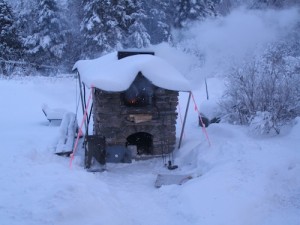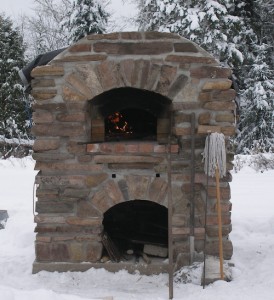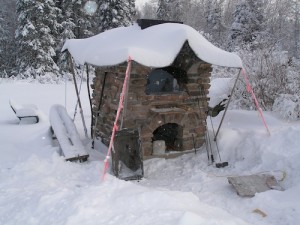Tim’s 32″ dome oven in winter
 So now it’s winter. That does not mean you are going to stop cooking in your WFO does it? Of course not. While cold weather can affect the fire in your oven, it can have an even bigger affect on the oven operator. Get a warm, non flammable coat that you can sacrifice … there will be soot! I draw my line in the snow at -20C and below that I prefer to look at my oven from the warmth of the house.
So now it’s winter. That does not mean you are going to stop cooking in your WFO does it? Of course not. While cold weather can affect the fire in your oven, it can have an even bigger affect on the oven operator. Get a warm, non flammable coat that you can sacrifice … there will be soot! I draw my line in the snow at -20C and below that I prefer to look at my oven from the warmth of the house.
As you would expect, the colder it is outside, the more wood and time it will take to get your oven to cooking temperature. I add at least one more charge of wood, adding another 45 mins. Your actual firing time as they say, will vary. The ambient temperature of the bricks also comes into play. Just like the thermal mass and insulation of your oven holds the heat, it can also hold on to that record cold snap for several days afterward. 
More thermal insulation the better. The thicker the thermal insulating layer, especially on the top of the oven and around sides, the better.
To stop thermal shock on your ice cold bricks [i.e. bricks/refractories breaking] you need a small and slow warm up fire. I start a small fire of kindling in between two lengths of wood that won’t ignite quickly and put a wider piece of wood on top to deflect the flames away from the dome, usually for 45 mins. to an hour. The lower inner bricks should be warm to the touch before you start adding wood to make your main fire.
Using your best, dry firewood will help to generate the BTU’s you will need to get your oven hot. As the coals build up I rake some of them towards the door to pre-heat the cold air entering the oven along the floor. Even though your oven will look and seem hot, the outer surface of your liner bricks against the insulation will be cool, and unless you lengthen the main fire time your oven will cool off quicker than in the warm weather.
 OK, so all this seems like even more work, there must be some redeeming aspects to this winter cooking. Well there are.
OK, so all this seems like even more work, there must be some redeeming aspects to this winter cooking. Well there are.
For starters, your beer will never get warm!
When you burn yourself on a hot pan you will have a ready supply of snow to put on the burn.
There are no annoying insects!
You can use the snow to stop something like roasted coffee from over roasting by placing the pan on the snow.
Your beverage will get even colder!
FYI, your beer will freeze at -5C, and your wine at -14C
Respond to the Tim’s 32″ dome oven in winter article:
5 Comments
Sorry, the comment form is closed at this time.
Nice idea. The best is the last tip about the drinks outside. What about vodka? It will not freeze only feel icy :) Practical cooking also in a freezing winter in wood fired ovens.
By oprawy oswietleniowe
Tim, I love the snow on your photos. And of course the stone work. I grew up in colder climate, in Czechoslovakia. I spent all 4 seasons there again a couple of years ago but that time winter was very mild. There’s not as brutally cold as I think it might be in Canada, though, but those -15 deg. Celsius ( +5 Fahrenheit °F ) from December till mid March was pretty common. I can remember even the -20 C ( -4 °F ) for about a week once or twice.
You are so right. The hot fumes don’t climb up too high in the freezing weather do they?! Only one thing I would like to add. Maybe you forgot to mention this. Similarly as with raising the temperature up slowly with a gentle fire at the beginning of the heat up; dropping the temperature slowly down is important too. It shouldn’t be rapid mainly at around +200C – 392F mark when silica starts to shrink. After cooking, especially in a winter cold conditions, it’s wise to leave the wooden door closed so cooling down back is nicely gradual. Basically the door closed deals with avoiding temperature differences in the material inside (and the cooking part is insulated on the outside).
When the door gets closed it’ll be the time for drying up some apples and prunes. But that’s if all of them were not already fermented or distilled for easy storage for the whole winter season :)
*Tim I cannot wait to hear about how you roast your coffee. Interesting. Something I would like to do too!
By Rado
Yes Rado is right , I did forget to mention about being quick with the door closure , that -15+ air can cool down the oven in a hurry .
tim
By tim
[…] Tim’s 32″ dome oven in winter » […]
Pingback roasting coffee in your wood oven
[…] Tim’s oven with metal roof finished. My wife an Artist / Blacksmith made these ribs for the roof plus all the metal front supports […]
Pingback Metal roof built on the arty stone structure!